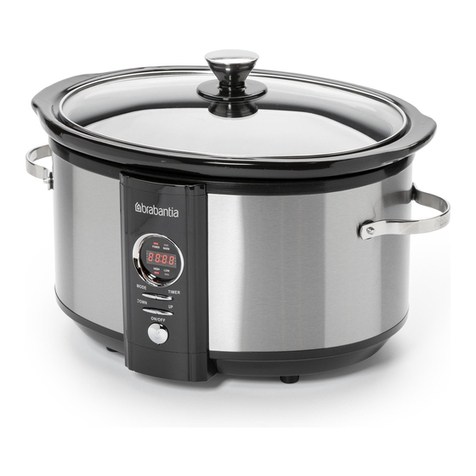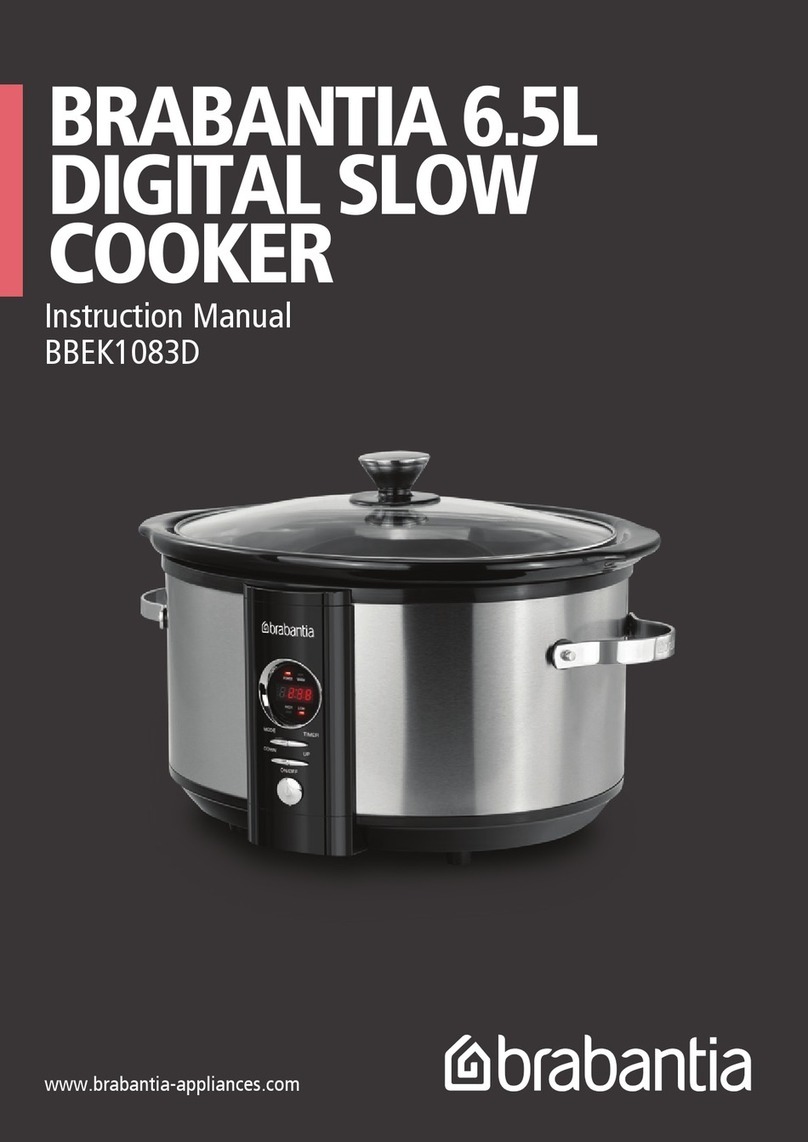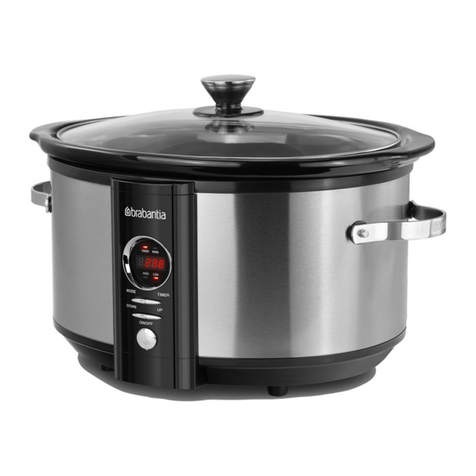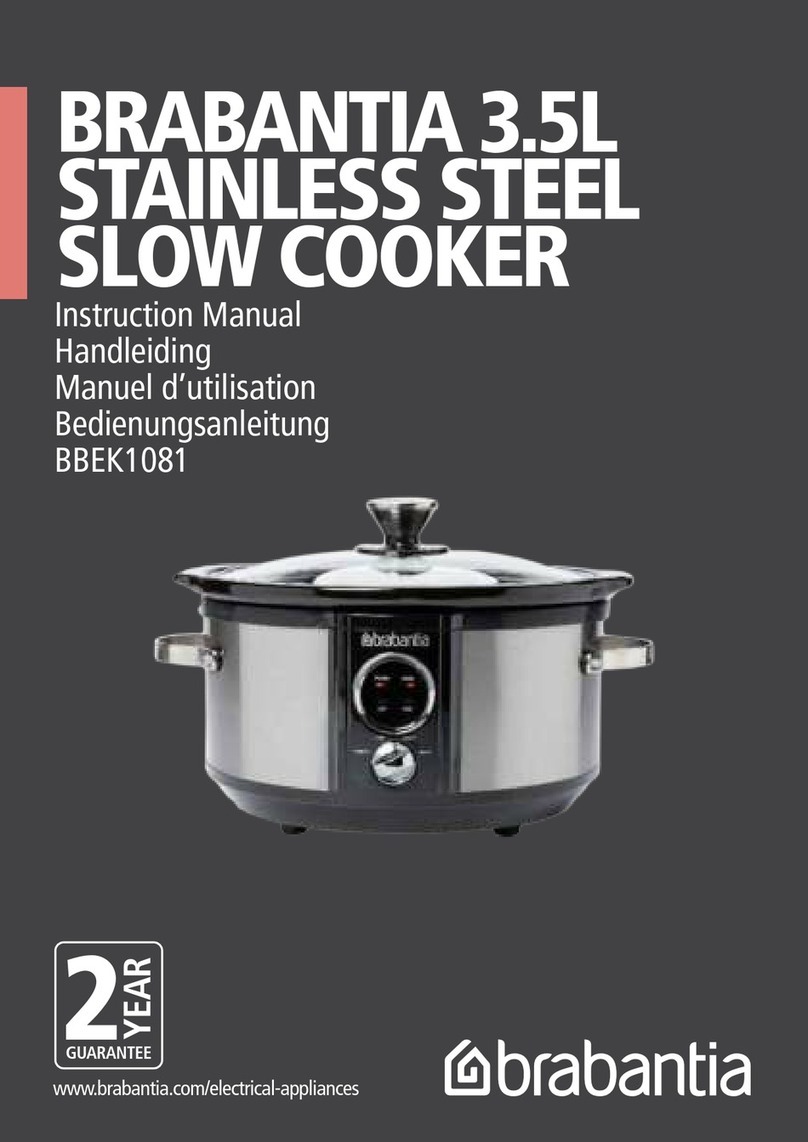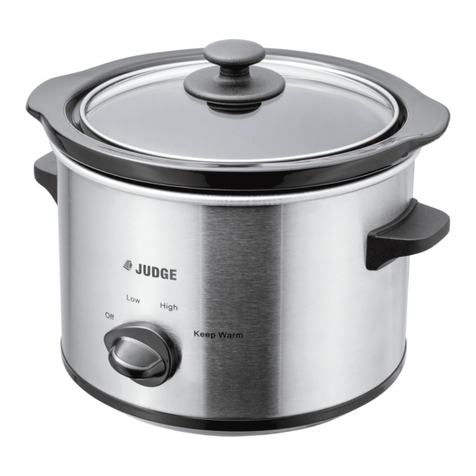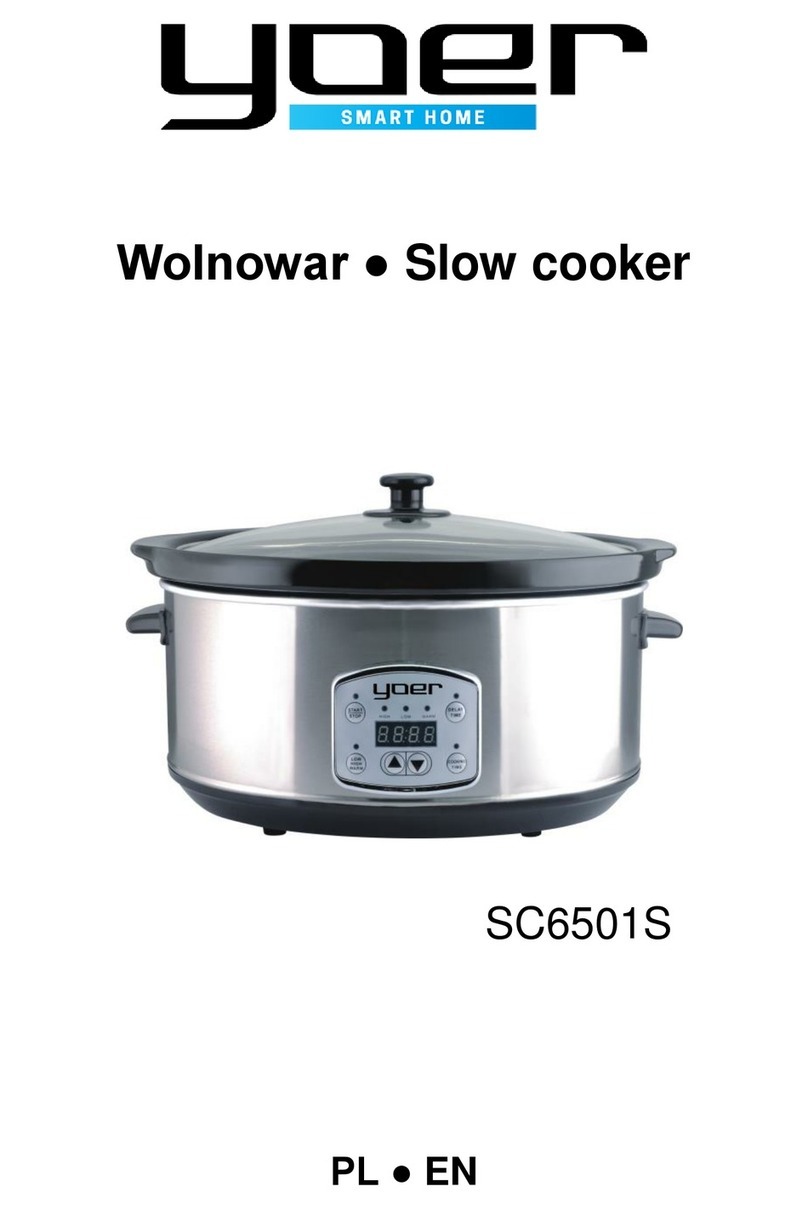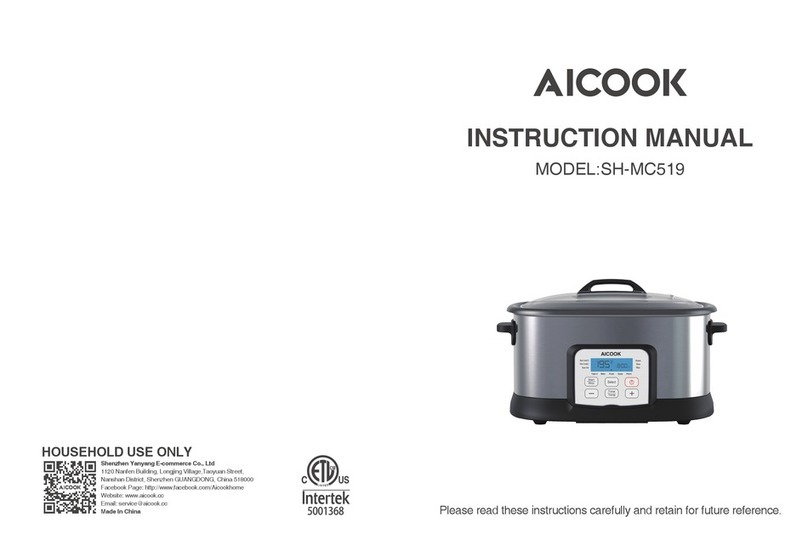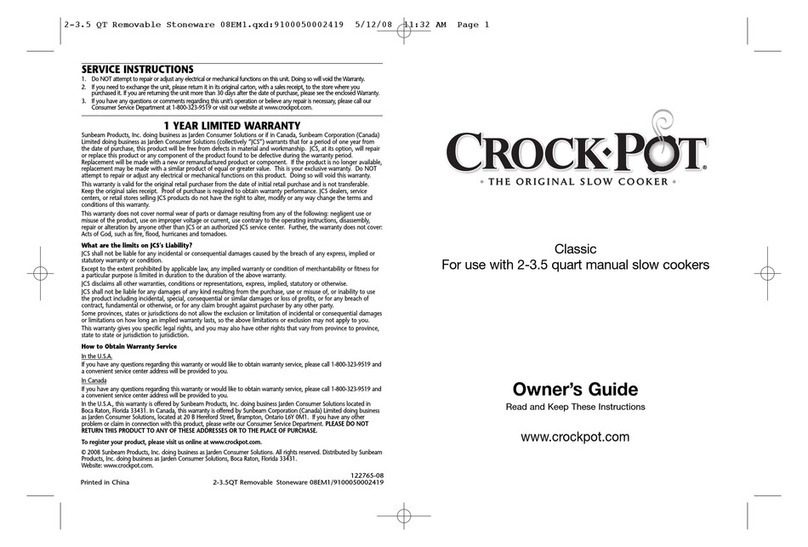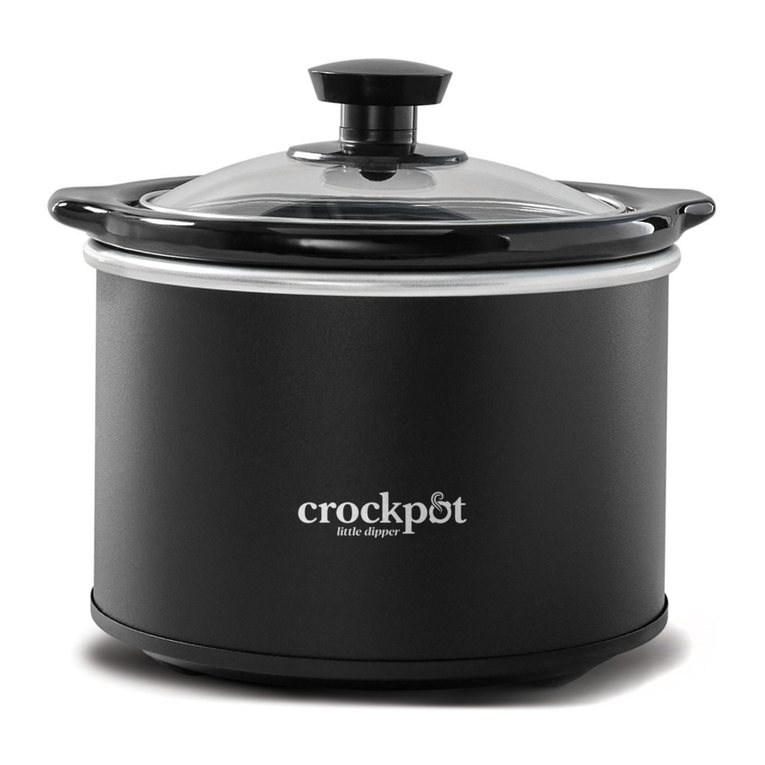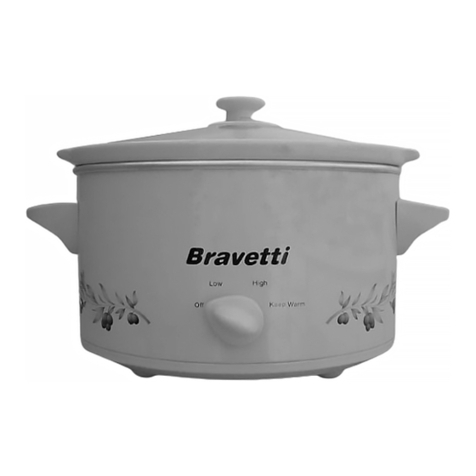Brabantia BBEK1081RD User manual

BRABANTIA 3.5L
DIGITAL SLOW
COOKER
Instruction Manual
BBEK1081RD
www.brabantia-appliances.com

THANK YOU FOR
PURCHASING OUR
3.5L DIGITAL
SLOW COOKER
We hope it will delight you and
that it will get a special place in
your home. Enjoy!

IMPORTANT SAFEGUARDS
1. Please read through the following safety precautions carefully before switching the
Slow Cooker on.
2. Keep this instruction manual in a safe place for future reference. Keep the sales
receipt and, if possible, the gift box with the inner packaging.
3. Failure to follow all the instructions may result in electric shock, fire or serious
personal injury.
4. Before plugging the Slow Cooker into the mains electrical supply, check that the
voltage and power supply comply with the specifications indicated on the rating
plate of the appliance.
5. Do not plug the appliance into the power supply until it is fully assembled and
always unplug before disassembling the appliance.
6. The Slow Cooker is not intended for use by persons (including children) with
reduced physical, sensory or mental capabilities, or lack of experience and
knowledge, unless they have been given supervision or instruction concerning use
of the appliance by a person responsible for their safety.
7. The Slow Cooker is not intended for operation by means of an external timer or a
separate remote control system.
8. Always place the Slow Cooker on a stable, flat, heat-resistant surface. Ensure that
the surface can take the weight of the unit during use.
9. This appliance is only intended for household use and other similar domestic
situations such as: in staff kitchen areas in shops, offices and other working
environments; by guests in hotels, motels and other residential type environments;
in guest houses and bed and breakfast establishments.
10. Always keep the Slow Cooker out of the reach of children. Close adult supervision
is necessary when the Slow Cooker is used by or near children.
11. Do not leave the unit unattended when not in use.
12. Do not move or lift the Slow Cooker while it is operating or while it is connected to
an electrical socket.
13. Do not leave the base unit switched on without the bowl in place.
14. The use of attachments not specifically recommended by the manufacturer, must
not be used as they may cause personal injury or damage to the appliance.
15. Do not operate the Slow Cooker if the plug or power cord has been damaged, is
not working properly, has been dropped or has been exposed to water or other
liquid.
16. Regularly check the Slow Cooker power cord carefully for signs of damage. If the
power cord is damaged in any way, the manufacturer or its service agent or a
similarly qualified person must replace it in order to avoid an electrical hazard.
17. Do not allow the power cord to hang over sharp table edges or come into contact
with hot surfaces.
18. Make sure that the Slow Cooker is switched off and remove the plug from the
mains electrical supply when it is not in use,before it is cleaned, before changing
accessories or moving parts and while it is being repaired.
19. Use oven gloves when handling the pot or removing the glass lid after use.
20. Ensure that the glass lid is allowed to cool before immersing in water. Insufficient
cooling time will cause the lid to crack.
21. To prevent the risk of electrical shock, do not immerse the power cord, plug, or
any nonremovable parts of this Slow Cooker in water or any other liquid.
22. The Slow Cooker base must not be submerged in water as contact with the
electrical parts will cause a malfunction and/ or an electric shock. Do not use the
appliance with wet hands.
23. Do not use the Slow Cooker outdoors.
24. Always switch the power off before removing the plug from the mains electrical
supply.
25. To unplug the appliance, grasp the plug firmly and remove it from the mains
electrical supply. Do not pull on the cord.
26. Never use the Slow Cooker if it is damaged in any way.
27. Only an authorised service centre may carry out any repairs. Improper repairs may
place the user at risk.
28. When handing this product over to a third party, ensure that this instruction
manual is supplied with the appliance.

IMPORTANT SAFEGUARDS
1. Please read through the following safety precautions carefully before switching the
Slow Cooker on.
2. Keep this instruction manual in a safe place for future reference. Keep the sales
receipt and, if possible, the gift box with the inner packaging.
3. Failure to follow all the instructions may result in electric shock, fire or serious
personal injury.
4. Before plugging the Slow Cooker into the mains electrical supply, check that the
voltage and power supply comply with the specifications indicated on the rating
plate of the appliance.
5. Do not plug the appliance into the power supply until it is fully assembled and
always unplug before disassembling the appliance.
6. The Slow Cooker is not intended for use by persons (including children) with
reduced physical, sensory or mental capabilities, or lack of experience and
knowledge, unless they have been given supervision or instruction concerning use
of the appliance by a person responsible for their safety.
7. The Slow Cooker is not intended for operation by means of an external timer or a
separate remote control system.
8. Always place the Slow Cooker on a stable, flat, heat-resistant surface. Ensure that
the surface can take the weight of the unit during use.
9. This appliance is only intended for household use and other similar domestic
situations such as: in staff kitchen areas in shops, offices and other working
environments; by guests in hotels, motels and other residential type environments;
in guest houses and bed and breakfast establishments.
10. Always keep the Slow Cooker out of the reach of children. Close adult supervision
is necessary when the Slow Cooker is used by or near children.
11. Do not leave the unit unattended when not in use.
12. Do not move or lift the Slow Cooker while it is operating or while it is connected to
an electrical socket.
13. Do not leave the base unit switched on without the bowl in place.
14. The use of attachments not specifically recommended by the manufacturer, must
not be used as they may cause personal injury or damage to the appliance.
15. Do not operate the Slow Cooker if the plug or power cord has been damaged, is
not working properly, has been dropped or has been exposed to water or other
liquid.
16. Regularly check the Slow Cooker power cord carefully for signs of damage. If the
power cord is damaged in any way, the manufacturer or its service agent or a
similarly qualified person must replace it in order to avoid an electrical hazard.
17. Do not allow the power cord to hang over sharp table edges or come into contact
with hot surfaces.
18. Make sure that the Slow Cooker is switched off and remove the plug from the
mains electrical supply when it is not in use,before it is cleaned, before changing
accessories or moving parts and while it is being repaired.
19. Use oven gloves when handling the pot or removing the glass lid after use.
20. Ensure that the glass lid is allowed to cool before immersing in water. Insufficient
cooling time will cause the lid to crack.
21. To prevent the risk of electrical shock, do not immerse the power cord, plug, or
any nonremovable parts of this Slow Cooker in water or any other liquid.
22. The Slow Cooker base must not be submerged in water as contact with the
electrical parts will cause a malfunction and/ or an electric shock. Do not use the
appliance with wet hands.
23. Do not use the Slow Cooker outdoors.
24. Always switch the power off before removing the plug from the mains electrical
supply.
25. To unplug the appliance, grasp the plug firmly and remove it from the mains
electrical supply. Do not pull on the cord.
26. Never use the Slow Cooker if it is damaged in any way.
27. Only an authorised service centre may carry out any repairs. Improper repairs may
place the user at risk.
28. When handing this product over to a third party, ensure that this instruction
manual is supplied with the appliance.

11
4
12
6
7
8
9
10
3
5
2
1
KNOW YOUR SLOW COOKER
1: Removable ceramic bowl
2: Stainless steel housing
3: Control panel
4: Tempered glass lid
5: Display
6: Power indicator light
7: Warm indicator light
8: High indicator light
9: Low indicator light
10: Control knob
11: Lid handle
12: Side handle

HOW TO USE YOUR SLOW COOKER
Before first use:
1. Wash the removable ceramic bowl in hot soapy water, then rinse and dry before
first use.
2. When you use your Slow Cooker for the first time, you may notice a slight odour
due to the burning off of manufacturing residues. This will disappear after using a
few times.
3. Ensure that you place your Slow Cooker on a clear, flat work surface near a suitable
socket outlet.
4. Place the food in the ceramic cooking pot.
5. To avoid electric shock, do not use the heating unit for cooking.
Operation
1. Plug the power cord into a suitable electrical socket.
2. There are 3 temperature settings.
- LOW is recommended for slow "all day" cooking.
- HIGH provides faster cooking (1 hour on HIGH is equalto about 2 hours on LOW).
- WARM is only for keeping food warm. Do not cook on the WARM setting.
3. To select the temperature, turn the control knob to the required setting.
4. If you need to pre-cook or brown food prior to slow cooking, this must be done in a
pan. Do not try to brown or pre-cook food in the Slow Cooker.
5. Frozen foods may be used as part of a recipe. However, add at least 250ml of warm
liquid to the ceramic bowl if cooking frozen meats such as beef or chicken.
6. Always cook with the lid on.
7. Please note that the Slow Cooker must not be overfilled. The ceramic bowl should
never be more than 3/4 full.
8. When the cooking time is completed,turn the control knob to the WARM setting
until the food is required.
9. NOTE: Do not use the WARM setting for more than 4 hours.
10. To turn the Slow Cooker off, turn the control knob to 'OFF' and unplug the
appliance from the mains electrical supply.
11. Do not use the Slow Cooker to store food.
12. Do not re-heat food in your Slow Cooker.
13. Do not place the heated Slow Cooker, filled with food, on an unprotected wooden
table.
14. Do not use the ceramic cooking pot in an oven or a microwave, on a gas or electric
hob, or under a grill.
15. NOTE: The lid is not ovenproof or microwave safe.
HINTS ON SLOW COOKING
1. Slow cooking is a gentle method of cooking which retains both the flavour and the
nutrients in food. Slow cooking allows one to select cheaper cuts of meat knowing
that when the cooking process is complete, the meat will be tender and succulent.
In addition more delicate foods such as fish, fruit and vegetables will not break up
during the cooking process.
2. Some food/ ingredients are not suited for extended cooking in the Slow Cooker.
Pasta; seafood; milk; cream or sour cream should be added 2 hours before serving.
Evaporated milk or condensed soups are perfect for the Slow Cooker.
MANY FACTORS WILL INFLUENCE THE WAY THAT FOOD WILL
COOK IN A SLOW COOKER SUCH AS:
1. The water and fat content of the ingredients.
2. The temperature.
3. The size of the ingredients.
4. Ingredients cut into pieces will cook faster than whole roasts or poultry.
5. Most meat and vegetable combinations require at least 7 hours cooking on LOW.
6. The higher the fat content of the meat,the less liquid is needed.
7. When cooking meat with a high fat content, place thick onion slices underneath, so
that the meat will not be immersed in fat. Some recipes call for browning of the
meat prior to slow cooking in order to remove excess fat or to brown the food.
8. Slow Cookers have very little evaporation. When making your favourite soup stew
or sauce, reduce the liquid or water called for in the original recipe. If the soup,
stew or sauce is too thick, liquids can be added later. When cooking a
vegetable-type casserole, add liquid to the recipe to prevent scorching on the sides.
GENERAL GUIDELINES
1. Always ensure that boiling liquid is used to add to the cooking bowl. Never add
cold water.
2. Always use either metric or imperial measurements. Do not use a mixture of
measurements.
3. Always wear oven gloves when handling the Slow Cooker when it is in use.
4. Dried beans e.g. dried red kidney beans must be soaked overnight. They should be
boiled for 10-15 minutes before placing them in the Slow Cooker.
5. Add tinned beans 30-45 minutes before the end of the cooking time.
6. Rice, noodles and pasta are not recommended for long cooking times (with the
exception of sago). Cook separately and then add during the last 30 minutes of
cooking time.
7. Never place frozen meat or poultry directly into the Slow Cooker. Add at least
250ml warm water to the cooking pot before adding the frozen meat or poultry.
8. When cooking a meat and root vegetable combination always place the root
vegetables at the bottom of the bowl, as they take longer to cook.
9. Do not fill the cooker to the rim with food. The ceramic bowl should never be more
than 3/4 full.
10. Always cook with the lid on and the ceramic bowl in position. Remember that
frequently lifting the lid during cooking will extend the cooking time. Do not lift the
lid during the first half of the cooking time.
11. Always ensure that the food is thoroughly cooked before eating.
NOTE:
1. The Slow Cooker can operate on LOW all day and night if required. When on the
HIGH setting it will cook similarly to a covered pot on a stove, so food will cook in
approximately half the cooking time required for LOW temperature cooking.
2. When cooking on the HIGH setting, additional liquid may be required. as food does.
CONVERTING STANDARD RECIPES/ COOKING TIMES FOR
SLOW COOKING
1. Vegetables such as carrots, potatoes and turnips require longer cooking than many
types of meat. Place them on the bottom of the bowl and cover with liquid.
2. If adding fresh milk or yoghurt, this should be done during the last 2 hours.
Evaporated milk may be added at the start of cooking.
3. Rice, noodles and pasta are not recommended for long cooking periods. Cook them
separately and then add to the Slow Cooker during the last 30 minutes.
4. Many of your favourite recipes can be adapted to the Slow Cooker.
5. Use the following table as a guide.
CLEANING AND MAINTENANCE
1. Before cleaning,ensure that the Slow Cooker is unplugged from the mains electrical
supply.
2. Always allow the unit to cool down completely.
3. Remove the glass lid and the ceramic bowl and wash them in hot soapy water. If
any food is attached to the bottom, soak the ceramic bowl in warm water and
then scrub gently with a plastic scourer or brush. Rinse and dry thoroughly.
4. Do not immerse the outer body in water or any other liquid.
5. Wipe the body of the Slow Cooker with a damp cloth and use a dry cloth to wipe
down the interior.
6. Do not use any abrasive cleaners as these may damage the finish on the outer
housing.
7. Do not fill the ceramic bowl with cold water if the bowl is still warm after
cooking.
8. Avoid subjecting the cooking pot to rapid changes of temperature,such as
pouring cold water into a warm cooking pot, as this may cause damage to the
cooking pot.
ENVIRONMENT FRIENDLY DISPOSAL
This marking indicates that this product should not be disposed of with
other household waste. To prevent possible harm to the environment or
human health from uncontrolled waste disposal, recycle it responsibly to
promote the sustainable re-use of material resources. To dispose of your
appliance correctly, please contact or take it to your local refuse/recycling
centre. Alternatively, contact your local council for information on your local re-use
centre. Please make this product environmentally safe for recycling.
WARRANTY
In the unlikely event that you have a problem with your Brabantia appliance, please
be aware that your Brabantia appliance has a warranty.
Warranty exclusions:
The warranty will not be valid if:
1. The product has not been installed, operated or maintained in accordance with
the manufacturer's operating instructions provided with the product.
2. The product has been used for any purpose other than its intended function.
3. The damage or malfunction of the product is caused by any of the following:
- Incorrect voltage
- Accidents (including liquid or moisture damage)
- Misuse or abuse of the product
- Faulty or improper installation
- Mains supply problems, including power spikes or lightning damage
- Infestation by insects
- Tampering or modification of the product by persons other than authorised
service personnel
- Exposure to abnormally corrosive materials
- Insertion of foreign objects into the unit
- Usage with accessories not pre-approved by Brabantia
Please refer to and heed all warnings and precautions in this Instruction
Manual.
Due to continuous product development, specifications may be subject to
change without prior notification.

HOW TO USE YOUR SLOW COOKER
Before first use:
1. Wash the removable ceramic bowl in hot soapy water, then rinse and dry before
first use.
2. When you use your Slow Cooker for the first time, you may notice a slight odour
due to the burning off of manufacturing residues. This will disappear after using a
few times.
3. Ensure that you place your Slow Cooker on a clear, flat work surface near a suitable
socket outlet.
4. Place the food in the ceramic cooking pot.
5. To avoid electric shock, do not use the heating unit for cooking.
Operation
1. Plug the power cord into a suitable electrical socket.
2. There are 3 temperature settings.
- LOW is recommended for slow "all day" cooking.
- HIGH provides faster cooking (1 hour on HIGH is equalto about 2 hours on LOW).
- WARM is only for keeping food warm. Do not cook on the WARM setting.
3. To select the temperature, turn the control knob to the required setting.
4. If you need to pre-cook or brown food prior to slow cooking, this must be done in a
pan. Do not try to brown or pre-cook food in the Slow Cooker.
5. Frozen foods may be used as part of a recipe. However, add at least 250ml of warm
liquid to the ceramic bowl if cooking frozen meats such as beef or chicken.
6. Always cook with the lid on.
7. Please note that the Slow Cooker must not be overfilled. The ceramic bowl should
never be more than 3/4 full.
8. When the cooking time is completed,turn the control knob to the WARM setting
until the food is required.
9. NOTE: Do not use the WARM setting for more than 4 hours.
10. To turn the Slow Cooker off, turn the control knob to 'OFF' and unplug the
appliance from the mains electrical supply.
11. Do not use the Slow Cooker to store food.
12. Do not re-heat food in your Slow Cooker.
13. Do not place the heated Slow Cooker, filled with food, on an unprotected wooden
table.
14. Do not use the ceramic cooking pot in an oven or a microwave, on a gas or electric
hob, or under a grill.
15. NOTE: The lid is not ovenproof or microwave safe.
HINTS ON SLOW COOKING
1. Slow cooking is a gentle method of cooking which retains both the flavour and the
nutrients in food. Slow cooking allows one to select cheaper cuts of meat knowing
that when the cooking process is complete, the meat will be tender and succulent.
In addition more delicate foods such as fish, fruit and vegetables will not break up
during the cooking process.
2. Some food/ ingredients are not suited for extended cooking in the Slow Cooker.
Pasta; seafood; milk; cream or sour cream should be added 2 hours before serving.
Evaporated milk or condensed soups are perfect for the Slow Cooker.
MANY FACTORS WILL INFLUENCE THE WAY THAT FOOD WILL
COOK IN A SLOW COOKER SUCH AS:
1. The water and fat content of the ingredients.
2. The temperature.
3. The size of the ingredients.
4. Ingredients cut into pieces will cook faster than whole roasts or poultry.
5. Most meat and vegetable combinations require at least 7 hours cooking on LOW.
6. The higher the fat content of the meat,the less liquid is needed.
7. When cooking meat with a high fat content, place thick onion slices underneath, so
that the meat will not be immersed in fat. Some recipes call for browning of the
meat prior to slow cooking in order to remove excess fat or to brown the food.
8. Slow Cookers have very little evaporation. When making your favourite soup stew
or sauce, reduce the liquid or water called for in the original recipe. If the soup,
stew or sauce is too thick, liquids can be added later. When cooking a
vegetable-type casserole, add liquid to the recipe to prevent scorching on the sides.
GENERAL GUIDELINES
1. Always ensure that boiling liquid is used to add to the cooking bowl. Never add
cold water.
2. Always use either metric or imperial measurements. Do not use a mixture of
measurements.
3. Always wear oven gloves when handling the Slow Cooker when it is in use.
4. Dried beans e.g. dried red kidney beans must be soaked overnight. They should be
boiled for 10-15 minutes before placing them in the Slow Cooker.
5. Add tinned beans 30-45 minutes before the end of the cooking time.
6. Rice, noodles and pasta are not recommended for long cooking times (with the
exception of sago). Cook separately and then add during the last 30 minutes of
cooking time.
7. Never place frozen meat or poultry directly into the Slow Cooker. Add at least
250ml warm water to the cooking pot before adding the frozen meat or poultry.
8. When cooking a meat and root vegetable combination always place the root
vegetables at the bottom of the bowl, as they take longer to cook.
9. Do not fill the cooker to the rim with food. The ceramic bowl should never be more
than 3/4 full.
10. Always cook with the lid on and the ceramic bowl in position. Remember that
frequently lifting the lid during cooking will extend the cooking time. Do not lift the
lid during the first half of the cooking time.
11. Always ensure that the food is thoroughly cooked before eating.
NOTE:
1. The Slow Cooker can operate on LOW all day and night if required. When on the
HIGH setting it will cook similarly to a covered pot on a stove, so food will cook in
approximately half the cooking time required for LOW temperature cooking.
2. When cooking on the HIGH setting, additional liquid may be required. as food does.
CONVERTING STANDARD RECIPES/ COOKING TIMES FOR
SLOW COOKING
1. Vegetables such as carrots, potatoes and turnips require longer cooking than many
types of meat. Place them on the bottom of the bowl and cover with liquid.
2. If adding fresh milk or yoghurt, this should be done during the last 2 hours.
Evaporated milk may be added at the start of cooking.
3. Rice, noodles and pasta are not recommended for long cooking periods. Cook them
separately and then add to the Slow Cooker during the last 30 minutes.
4. Many of your favourite recipes can be adapted to the Slow Cooker.
5. Use the following table as a guide.
CLEANING AND MAINTENANCE
1. Before cleaning,ensure that the Slow Cooker is unplugged from the mains electrical
supply.
2. Always allow the unit to cool down completely.
3. Remove the glass lid and the ceramic bowl and wash them in hot soapy water. If
any food is attached to the bottom, soak the ceramic bowl in warm water and
then scrub gently with a plastic scourer or brush. Rinse and dry thoroughly.
4. Do not immerse the outer body in water or any other liquid.
5. Wipe the body of the Slow Cooker with a damp cloth and use a dry cloth to wipe
down the interior.
6. Do not use any abrasive cleaners as these may damage the finish on the outer
housing.
7. Do not fill the ceramic bowl with cold water if the bowl is still warm after
cooking.
8. Avoid subjecting the cooking pot to rapid changes of temperature,such as
pouring cold water into a warm cooking pot, as this may cause damage to the
cooking pot.
ENVIRONMENT FRIENDLY DISPOSAL
This marking indicates that this product should not be disposed of with
other household waste. To prevent possible harm to the environment or
human health from uncontrolled waste disposal, recycle it responsibly to
promote the sustainable re-use of material resources. To dispose of your
appliance correctly, please contact or take it to your local refuse/recycling
centre. Alternatively, contact your local council for information on your local re-use
centre. Please make this product environmentally safe for recycling.
WARRANTY
In the unlikely event that you have a problem with your Brabantia appliance, please
be aware that your Brabantia appliance has a warranty.
Warranty exclusions:
The warranty will not be valid if:
1. The product has not been installed, operated or maintained in accordance with
the manufacturer's operating instructions provided with the product.
2. The product has been used for any purpose other than its intended function.
3. The damage or malfunction of the product is caused by any of the following:
- Incorrect voltage
- Accidents (including liquid or moisture damage)
- Misuse or abuse of the product
- Faulty or improper installation
- Mains supply problems, including power spikes or lightning damage
- Infestation by insects
- Tampering or modification of the product by persons other than authorised
service personnel
- Exposure to abnormally corrosive materials
- Insertion of foreign objects into the unit
- Usage with accessories not pre-approved by Brabantia
Please refer to and heed all warnings and precautions in this Instruction
Manual.
Due to continuous product development, specifications may be subject to
change without prior notification.

HOW TO USE YOUR SLOW COOKER
Before first use:
1. Wash the removable ceramic bowl in hot soapy water, then rinse and dry before
first use.
2. When you use your Slow Cooker for the first time, you may notice a slight odour
due to the burning off of manufacturing residues. This will disappear after using a
few times.
3. Ensure that you place your Slow Cooker on a clear, flat work surface near a suitable
socket outlet.
4. Place the food in the ceramic cooking pot.
5. To avoid electric shock, do not use the heating unit for cooking.
Operation
1. Plug the power cord into a suitable electrical socket.
2. There are 3 temperature settings.
- LOW is recommended for slow "all day" cooking.
- HIGH provides faster cooking (1 hour on HIGH is equalto about 2 hours on LOW).
- WARM is only for keeping food warm. Do not cook on the WARM setting.
3. To select the temperature, turn the control knob to the required setting.
4. If you need to pre-cook or brown food prior to slow cooking, this must be done in a
pan. Do not try to brown or pre-cook food in the Slow Cooker.
5. Frozen foods may be used as part of a recipe. However, add at least 250ml of warm
liquid to the ceramic bowl if cooking frozen meats such as beef or chicken.
6. Always cook with the lid on.
7. Please note that the Slow Cooker must not be overfilled. The ceramic bowl should
never be more than 3/4 full.
8. When the cooking time is completed,turn the control knob to the WARM setting
until the food is required.
9. NOTE: Do not use the WARM setting for more than 4 hours.
10. To turn the Slow Cooker off, turn the control knob to 'OFF' and unplug the
appliance from the mains electrical supply.
11. Do not use the Slow Cooker to store food.
12. Do not re-heat food in your Slow Cooker.
13. Do not place the heated Slow Cooker, filled with food, on an unprotected wooden
table.
14. Do not use the ceramic cooking pot in an oven or a microwave, on a gas or electric
hob, or under a grill.
15. NOTE: The lid is not ovenproof or microwave safe.
HINTS ON SLOW COOKING
1. Slow cooking is a gentle method of cooking which retains both the flavour and the
nutrients in food. Slow cooking allows one to select cheaper cuts of meat knowing
that when the cooking process is complete, the meat will be tender and succulent.
In addition more delicate foods such as fish, fruit and vegetables will not break up
during the cooking process.
2. Some food/ ingredients are not suited for extended cooking in the Slow Cooker.
Pasta; seafood; milk; cream or sour cream should be added 2 hours before serving.
Evaporated milk or condensed soups are perfect for the Slow Cooker.
MANY FACTORS WILL INFLUENCE THE WAY THAT FOOD WILL
COOK IN A SLOW COOKER SUCH AS:
1. The water and fat content of the ingredients.
2. The temperature.
3. The size of the ingredients.
4. Ingredients cut into pieces will cook faster than whole roasts or poultry.
5. Most meat and vegetable combinations require at least 7 hours cooking on LOW.
6. The higher the fat content of the meat,the less liquid is needed.
7. When cooking meat with a high fat content, place thick onion slices underneath, so
that the meat will not be immersed in fat. Some recipes call for browning of the
meat prior to slow cooking in order to remove excess fat or to brown the food.
8. Slow Cookers have very little evaporation. When making your favourite soup stew
or sauce, reduce the liquid or water called for in the original recipe. If the soup,
stew or sauce is too thick, liquids can be added later. When cooking a
vegetable-type casserole, add liquid to the recipe to prevent scorching on the sides.
GENERAL GUIDELINES
1. Always ensure that boiling liquid is used to add to the cooking bowl. Never add
cold water.
2. Always use either metric or imperial measurements. Do not use a mixture of
measurements.
3. Always wear oven gloves when handling the Slow Cooker when it is in use.
4. Dried beans e.g. dried red kidney beans must be soaked overnight. They should be
boiled for 10-15 minutes before placing them in the Slow Cooker.
5. Add tinned beans 30-45 minutes before the end of the cooking time.
6. Rice, noodles and pasta are not recommended for long cooking times (with the
exception of sago). Cook separately and then add during the last 30 minutes of
cooking time.
7. Never place frozen meat or poultry directly into the Slow Cooker. Add at least
250ml warm water to the cooking pot before adding the frozen meat or poultry.
8. When cooking a meat and root vegetable combination always place the root
vegetables at the bottom of the bowl, as they take longer to cook.
9. Do not fill the cooker to the rim with food. The ceramic bowl should never be more
than 3/4 full.
10. Always cook with the lid on and the ceramic bowl in position. Remember that
frequently lifting the lid during cooking will extend the cooking time. Do not lift the
lid during the first half of the cooking time.
11. Always ensure that the food is thoroughly cooked before eating.
NOTE:
1. The Slow Cooker can operate on LOW all day and night if required. When on the
HIGH setting it will cook similarly to a covered pot on a stove, so food will cook in
approximately half the cooking time required for LOW temperature cooking.
2. When cooking on the HIGH setting, additional liquid may be required. as food does.
CONVERTING STANDARD RECIPES/ COOKING TIMES FOR
SLOW COOKING
1. Vegetables such as carrots, potatoes and turnips require longer cooking than many
types of meat. Place them on the bottom of the bowl and cover with liquid.
2. If adding fresh milk or yoghurt, this should be done during the last 2 hours.
Evaporated milk may be added at the start of cooking.
3. Rice, noodles and pasta are not recommended for long cooking periods. Cook them
separately and then add to the Slow Cooker during the last 30 minutes.
4. Many of your favourite recipes can be adapted to the Slow Cooker.
5. Use the following table as a guide.
CLEANING AND MAINTENANCE
1. Before cleaning,ensure that the Slow Cooker is unplugged from the mains electrical
supply.
2. Always allow the unit to cool down completely.
3. Remove the glass lid and the ceramic bowl and wash them in hot soapy water. If
any food is attached to the bottom, soak the ceramic bowl in warm water and
then scrub gently with a plastic scourer or brush. Rinse and dry thoroughly.
4. Do not immerse the outer body in water or any other liquid.
5. Wipe the body of the Slow Cooker with a damp cloth and use a dry cloth to wipe
down the interior.
6. Do not use any abrasive cleaners as these may damage the finish on the outer
housing.
7. Do not fill the ceramic bowl with cold water if the bowl is still warm after
cooking.
8. Avoid subjecting the cooking pot to rapid changes of temperature,such as
pouring cold water into a warm cooking pot, as this may cause damage to the
cooking pot.
ENVIRONMENT FRIENDLY DISPOSAL
This marking indicates that this product should not be disposed of with
other household waste. To prevent possible harm to the environment or
human health from uncontrolled waste disposal, recycle it responsibly to
promote the sustainable re-use of material resources. To dispose of your
appliance correctly, please contact or take it to your local refuse/recycling
centre. Alternatively, contact your local council for information on your local re-use
centre. Please make this product environmentally safe for recycling.
WARRANTY
In the unlikely event that you have a problem with your Brabantia appliance, please
be aware that your Brabantia appliance has a warranty.
Warranty exclusions:
The warranty will not be valid if:
1. The product has not been installed, operated or maintained in accordance with
the manufacturer's operating instructions provided with the product.
2. The product has been used for any purpose other than its intended function.
3. The damage or malfunction of the product is caused by any of the following:
- Incorrect voltage
- Accidents (including liquid or moisture damage)
- Misuse or abuse of the product
- Faulty or improper installation
- Mains supply problems, including power spikes or lightning damage
- Infestation by insects
- Tampering or modification of the product by persons other than authorised
service personnel
If recipe time stated is:
30 minutes
35-60 minutes
3 hours
Cook on high
3-4 hours
5-6 hours
7-8 hours
Cook on low
6-8 hours
8-10 hours
10-12 hours
- Exposure to abnormally corrosive materials
- Insertion of foreign objects into the unit
- Usage with accessories not pre-approved by Brabantia
Please refer to and heed all warnings and precautions in this Instruction
Manual.
Due to continuous product development, specifications may be subject to
change without prior notification.

HOW TO USE YOUR SLOW COOKER
Before first use:
1. Wash the removable ceramic bowl in hot soapy water, then rinse and dry before
first use.
2. When you use your Slow Cooker for the first time, you may notice a slight odour
due to the burning off of manufacturing residues. This will disappear after using a
few times.
3. Ensure that you place your Slow Cooker on a clear, flat work surface near a suitable
socket outlet.
4. Place the food in the ceramic cooking pot.
5. To avoid electric shock, do not use the heating unit for cooking.
Operation
1. Plug the power cord into a suitable electrical socket.
2. There are 3 temperature settings.
- LOW is recommended for slow "all day" cooking.
- HIGH provides faster cooking (1 hour on HIGH is equalto about 2 hours on LOW).
- WARM is only for keeping food warm. Do not cook on the WARM setting.
3. To select the temperature, turn the control knob to the required setting.
4. If you need to pre-cook or brown food prior to slow cooking, this must be done in a
pan. Do not try to brown or pre-cook food in the Slow Cooker.
5. Frozen foods may be used as part of a recipe. However, add at least 250ml of warm
liquid to the ceramic bowl if cooking frozen meats such as beef or chicken.
6. Always cook with the lid on.
7. Please note that the Slow Cooker must not be overfilled. The ceramic bowl should
never be more than 3/4 full.
8. When the cooking time is completed,turn the control knob to the WARM setting
until the food is required.
9. NOTE: Do not use the WARM setting for more than 4 hours.
10. To turn the Slow Cooker off, turn the control knob to 'OFF' and unplug the
appliance from the mains electrical supply.
11. Do not use the Slow Cooker to store food.
12. Do not re-heat food in your Slow Cooker.
13. Do not place the heated Slow Cooker, filled with food, on an unprotected wooden
table.
14. Do not use the ceramic cooking pot in an oven or a microwave, on a gas or electric
hob, or under a grill.
15. NOTE: The lid is not ovenproof or microwave safe.
HINTS ON SLOW COOKING
1. Slow cooking is a gentle method of cooking which retains both the flavour and the
nutrients in food. Slow cooking allows one to select cheaper cuts of meat knowing
that when the cooking process is complete, the meat will be tender and succulent.
In addition more delicate foods such as fish, fruit and vegetables will not break up
during the cooking process.
2. Some food/ ingredients are not suited for extended cooking in the Slow Cooker.
Pasta; seafood; milk; cream or sour cream should be added 2 hours before serving.
Evaporated milk or condensed soups are perfect for the Slow Cooker.
MANY FACTORS WILL INFLUENCE THE WAY THAT FOOD WILL
COOK IN A SLOW COOKER SUCH AS:
1. The water and fat content of the ingredients.
2. The temperature.
3. The size of the ingredients.
4. Ingredients cut into pieces will cook faster than whole roasts or poultry.
5. Most meat and vegetable combinations require at least 7 hours cooking on LOW.
6. The higher the fat content of the meat,the less liquid is needed.
7. When cooking meat with a high fat content, place thick onion slices underneath, so
that the meat will not be immersed in fat. Some recipes call for browning of the
meat prior to slow cooking in order to remove excess fat or to brown the food.
8. Slow Cookers have very little evaporation. When making your favourite soup stew
or sauce, reduce the liquid or water called for in the original recipe. If the soup,
stew or sauce is too thick, liquids can be added later. When cooking a
vegetable-type casserole, add liquid to the recipe to prevent scorching on the sides.
GENERAL GUIDELINES
1. Always ensure that boiling liquid is used to add to the cooking bowl. Never add
cold water.
2. Always use either metric or imperial measurements. Do not use a mixture of
measurements.
3. Always wear oven gloves when handling the Slow Cooker when it is in use.
4. Dried beans e.g. dried red kidney beans must be soaked overnight. They should be
boiled for 10-15 minutes before placing them in the Slow Cooker.
5. Add tinned beans 30-45 minutes before the end of the cooking time.
6. Rice, noodles and pasta are not recommended for long cooking times (with the
exception of sago). Cook separately and then add during the last 30 minutes of
cooking time.
7. Never place frozen meat or poultry directly into the Slow Cooker. Add at least
250ml warm water to the cooking pot before adding the frozen meat or poultry.
8. When cooking a meat and root vegetable combination always place the root
vegetables at the bottom of the bowl, as they take longer to cook.
9. Do not fill the cooker to the rim with food. The ceramic bowl should never be more
than 3/4 full.
10. Always cook with the lid on and the ceramic bowl in position. Remember that
frequently lifting the lid during cooking will extend the cooking time. Do not lift the
lid during the first half of the cooking time.
11. Always ensure that the food is thoroughly cooked before eating.
NOTE:
1. The Slow Cooker can operate on LOW all day and night if required. When on the
HIGH setting it will cook similarly to a covered pot on a stove, so food will cook in
approximately half the cooking time required for LOW temperature cooking.
2. When cooking on the HIGH setting, additional liquid may be required. as food does.
CONVERTING STANDARD RECIPES/ COOKING TIMES FOR
SLOW COOKING
1. Vegetables such as carrots, potatoes and turnips require longer cooking than many
types of meat. Place them on the bottom of the bowl and cover with liquid.
2. If adding fresh milk or yoghurt, this should be done during the last 2 hours.
Evaporated milk may be added at the start of cooking.
3. Rice, noodles and pasta are not recommended for long cooking periods. Cook them
separately and then add to the Slow Cooker during the last 30 minutes.
4. Many of your favourite recipes can be adapted to the Slow Cooker.
5. Use the following table as a guide.
CLEANING AND MAINTENANCE
1. Before cleaning,ensure that the Slow Cooker is unplugged from the mains electrical
supply.
2. Always allow the unit to cool down completely.
3. Remove the glass lid and the ceramic bowl and wash them in hot soapy water. If
any food is attached to the bottom, soak the ceramic bowl in warm water and
then scrub gently with a plastic scourer or brush. Rinse and dry thoroughly.
4. Do not immerse the outer body in water or any other liquid.
5. Wipe the body of the Slow Cooker with a damp cloth and use a dry cloth to wipe
down the interior.
6. Do not use any abrasive cleaners as these may damage the finish on the outer
housing.
7. Do not fill the ceramic bowl with cold water if the bowl is still warm after
cooking.
8. Avoid subjecting the cooking pot to rapid changes of temperature,such as
pouring cold water into a warm cooking pot, as this may cause damage to the
cooking pot.
ENVIRONMENT FRIENDLY DISPOSAL
This marking indicates that this product should not be disposed of with
other household waste. To prevent possible harm to the environment or
human health from uncontrolled waste disposal, recycle it responsibly to
promote the sustainable re-use of material resources. To dispose of your
appliance correctly, please contact or take it to your local refuse/recycling
centre. Alternatively, contact your local council for information on your local re-use
centre. Please make this product environmentally safe for recycling.
WARRANTY
In the unlikely event that you have a problem with your Brabantia appliance, please
be aware that your Brabantia appliance has a warranty.
Warranty exclusions:
The warranty will not be valid if:
1. The product has not been installed, operated or maintained in accordance with
the manufacturer's operating instructions provided with the product.
2. The product has been used for any purpose other than its intended function.
3. The damage or malfunction of the product is caused by any of the following:
- Incorrect voltage
- Accidents (including liquid or moisture damage)
- Misuse or abuse of the product
- Faulty or improper installation
- Mains supply problems, including power spikes or lightning damage
- Infestation by insects
- Tampering or modification of the product by persons other than authorised
service personnel
- Exposure to abnormally corrosive materials
- Insertion of foreign objects into the unit
- Usage with accessories not pre-approved by Brabantia
Please refer to and heed all warnings and precautions in this Instruction
Manual.
Due to continuous product development, specifications may be subject to
change without prior notification.

HOW TO USE YOUR SLOW COOKER
Before first use:
1. Wash the removable ceramic bowl in hot soapy water, then rinse and dry before
first use.
2. When you use your Slow Cooker for the first time, you may notice a slight odour
due to the burning off of manufacturing residues. This will disappear after using a
few times.
3. Ensure that you place your Slow Cooker on a clear, flat work surface near a suitable
socket outlet.
4. Place the food in the ceramic cooking pot.
5. To avoid electric shock, do not use the heating unit for cooking.
Operation
1. Plug the power cord into a suitable electrical socket.
2. There are 3 temperature settings.
- LOW is recommended for slow "all day" cooking.
- HIGH provides faster cooking (1 hour on HIGH is equalto about 2 hours on LOW).
- WARM is only for keeping food warm. Do not cook on the WARM setting.
3. To select the temperature, turn the control knob to the required setting.
4. If you need to pre-cook or brown food prior to slow cooking, this must be done in a
pan. Do not try to brown or pre-cook food in the Slow Cooker.
5. Frozen foods may be used as part of a recipe. However, add at least 250ml of warm
liquid to the ceramic bowl if cooking frozen meats such as beef or chicken.
6. Always cook with the lid on.
7. Please note that the Slow Cooker must not be overfilled. The ceramic bowl should
never be more than 3/4 full.
8. When the cooking time is completed,turn the control knob to the WARM setting
until the food is required.
9. NOTE: Do not use the WARM setting for more than 4 hours.
10. To turn the Slow Cooker off, turn the control knob to 'OFF' and unplug the
appliance from the mains electrical supply.
11. Do not use the Slow Cooker to store food.
12. Do not re-heat food in your Slow Cooker.
13. Do not place the heated Slow Cooker, filled with food, on an unprotected wooden
table.
14. Do not use the ceramic cooking pot in an oven or a microwave, on a gas or electric
hob, or under a grill.
15. NOTE: The lid is not ovenproof or microwave safe.
HINTS ON SLOW COOKING
1. Slow cooking is a gentle method of cooking which retains both the flavour and the
nutrients in food. Slow cooking allows one to select cheaper cuts of meat knowing
that when the cooking process is complete, the meat will be tender and succulent.
In addition more delicate foods such as fish, fruit and vegetables will not break up
during the cooking process.
2. Some food/ ingredients are not suited for extended cooking in the Slow Cooker.
Pasta; seafood; milk; cream or sour cream should be added 2 hours before serving.
Evaporated milk or condensed soups are perfect for the Slow Cooker.
MANY FACTORS WILL INFLUENCE THE WAY THAT FOOD WILL
COOK IN A SLOW COOKER SUCH AS:
1. The water and fat content of the ingredients.
2. The temperature.
3. The size of the ingredients.
4. Ingredients cut into pieces will cook faster than whole roasts or poultry.
5. Most meat and vegetable combinations require at least 7 hours cooking on LOW.
6. The higher the fat content of the meat,the less liquid is needed.
7. When cooking meat with a high fat content, place thick onion slices underneath, so
that the meat will not be immersed in fat. Some recipes call for browning of the
meat prior to slow cooking in order to remove excess fat or to brown the food.
8. Slow Cookers have very little evaporation. When making your favourite soup stew
or sauce, reduce the liquid or water called for in the original recipe. If the soup,
stew or sauce is too thick, liquids can be added later. When cooking a
vegetable-type casserole, add liquid to the recipe to prevent scorching on the sides.
GENERAL GUIDELINES
1. Always ensure that boiling liquid is used to add to the cooking bowl. Never add
cold water.
2. Always use either metric or imperial measurements. Do not use a mixture of
measurements.
3. Always wear oven gloves when handling the Slow Cooker when it is in use.
4. Dried beans e.g. dried red kidney beans must be soaked overnight. They should be
boiled for 10-15 minutes before placing them in the Slow Cooker.
5. Add tinned beans 30-45 minutes before the end of the cooking time.
6. Rice, noodles and pasta are not recommended for long cooking times (with the
exception of sago). Cook separately and then add during the last 30 minutes of
cooking time.
7. Never place frozen meat or poultry directly into the Slow Cooker. Add at least
250ml warm water to the cooking pot before adding the frozen meat or poultry.
8. When cooking a meat and root vegetable combination always place the root
vegetables at the bottom of the bowl, as they take longer to cook.
9. Do not fill the cooker to the rim with food. The ceramic bowl should never be more
than 3/4 full.
10. Always cook with the lid on and the ceramic bowl in position. Remember that
frequently lifting the lid during cooking will extend the cooking time. Do not lift the
lid during the first half of the cooking time.
11. Always ensure that the food is thoroughly cooked before eating.
NOTE:
1. The Slow Cooker can operate on LOW all day and night if required. When on the
HIGH setting it will cook similarly to a covered pot on a stove, so food will cook in
approximately half the cooking time required for LOW temperature cooking.
2. When cooking on the HIGH setting, additional liquid may be required. as food does.
CONVERTING STANDARD RECIPES/ COOKING TIMES FOR
SLOW COOKING
1. Vegetables such as carrots, potatoes and turnips require longer cooking than many
types of meat. Place them on the bottom of the bowl and cover with liquid.
2. If adding fresh milk or yoghurt, this should be done during the last 2 hours.
Evaporated milk may be added at the start of cooking.
3. Rice, noodles and pasta are not recommended for long cooking periods. Cook them
separately and then add to the Slow Cooker during the last 30 minutes.
4. Many of your favourite recipes can be adapted to the Slow Cooker.
5. Use the following table as a guide.
CLEANING AND MAINTENANCE
1. Before cleaning,ensure that the Slow Cooker is unplugged from the mains electrical
supply.
2. Always allow the unit to cool down completely.
3. Remove the glass lid and the ceramic bowl and wash them in hot soapy water. If
any food is attached to the bottom, soak the ceramic bowl in warm water and
then scrub gently with a plastic scourer or brush. Rinse and dry thoroughly.
4. Do not immerse the outer body in water or any other liquid.
5. Wipe the body of the Slow Cooker with a damp cloth and use a dry cloth to wipe
down the interior.
6. Do not use any abrasive cleaners as these may damage the finish on the outer
housing.
7. Do not fill the ceramic bowl with cold water if the bowl is still warm after
cooking.
8. Avoid subjecting the cooking pot to rapid changes of temperature,such as
pouring cold water into a warm cooking pot, as this may cause damage to the
cooking pot.
ENVIRONMENT FRIENDLY DISPOSAL
This marking indicates that this product should not be disposed of with
other household waste. To prevent possible harm to the environment or
human health from uncontrolled waste disposal, recycle it responsibly to
promote the sustainable re-use of material resources. To dispose of your
appliance correctly, please contact or take it to your local refuse/recycling
centre. Alternatively, contact your local council for information on your local re-use
centre. Please make this product environmentally safe for recycling.
WARRANTY
In the unlikely event that you have a problem with your Brabantia appliance, please
be aware that your Brabantia appliance has a warranty.
Warranty exclusions:
The warranty will not be valid if:
1. The product has not been installed, operated or maintained in accordance with
the manufacturer's operating instructions provided with the product.
2. The product has been used for any purpose other than its intended function.
3. The damage or malfunction of the product is caused by any of the following:
- Incorrect voltage
- Accidents (including liquid or moisture damage)
- Misuse or abuse of the product
- Faulty or improper installation
- Mains supply problems, including power spikes or lightning damage
- Infestation by insects
- Tampering or modification of the product by persons other than authorised
service personnel
- Exposure to abnormally corrosive materials
- Insertion of foreign objects into the unit
- Usage with accessories not pre-approved by Brabantia
Please refer to and heed all warnings and precautions in this Instruction
Manual.
Due to continuous product development, specifications may be subject to
change without prior notification.

BBEK1081RD 3.5L DIGITAL SLOW COOKER
PRODUCT INFORMATION
Manufactured by Rank Sharp Industries under
exclusive licence of Brabantia Nederland B.V.
Rank Sharp Industries
4th Floor of No. 3 Yuk Yat Street,
Tokwawan, Kowloon, Hong Kong
Table of contents
Other Brabantia Slow Cooker manuals
Popular Slow Cooker manuals by other brands
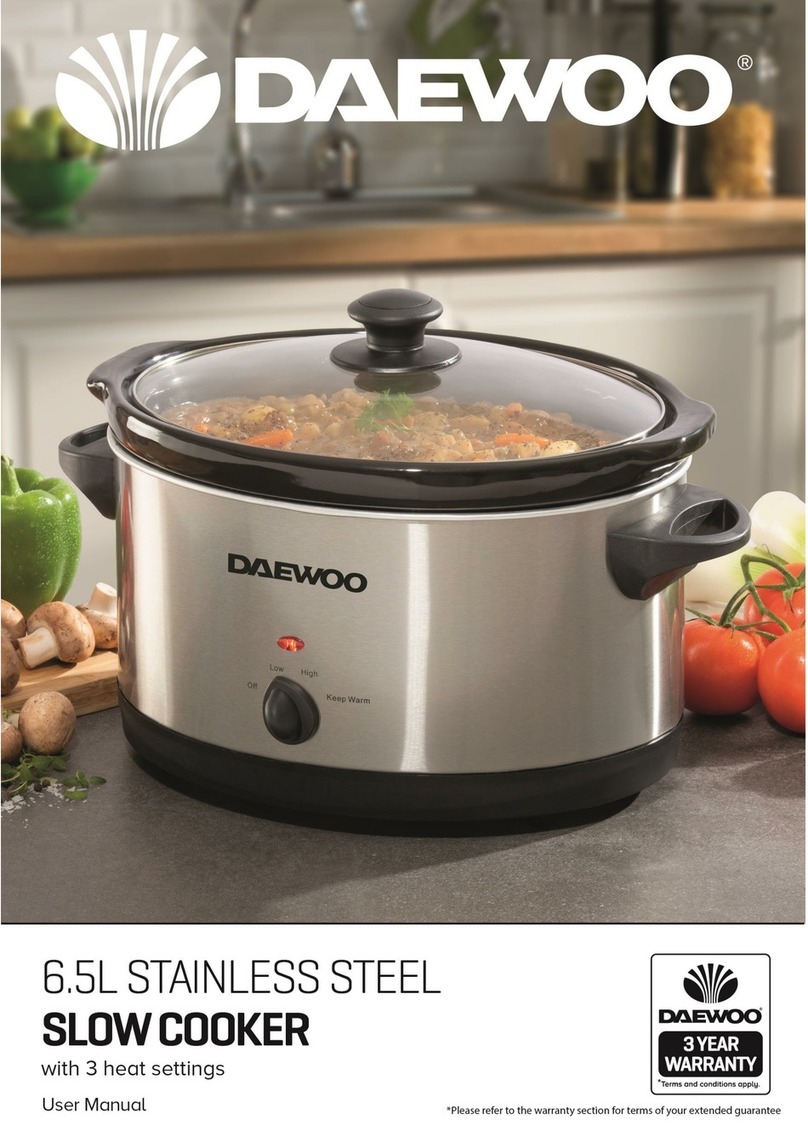
Daewoo
Daewoo SDA1788 user manual
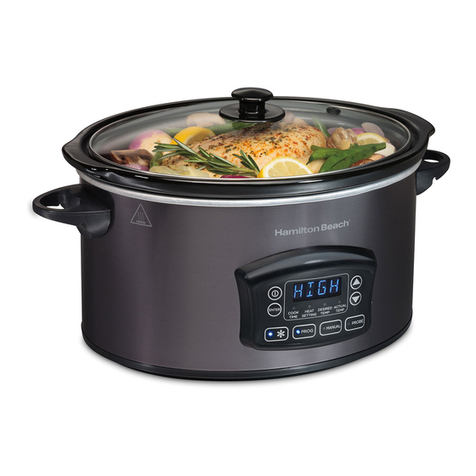
Hamilton Beach
Hamilton Beach 33768 manual
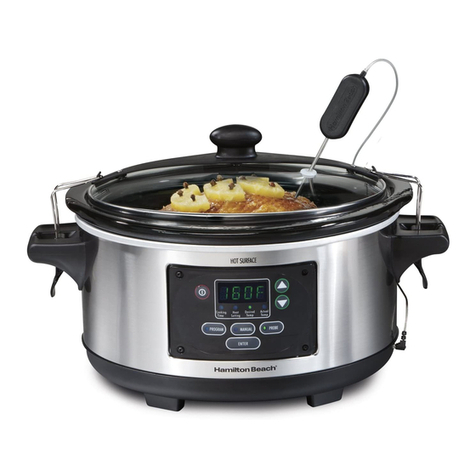
Hamilton Beach
Hamilton Beach Set 'n Forget 33863 use & care
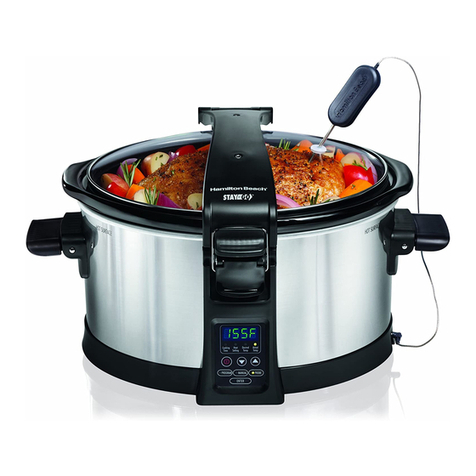
Hamilton Beach
Hamilton Beach Programmable Slow Cooker User instructions

Westinghouse
Westinghouse WHSC01SS instruction manual
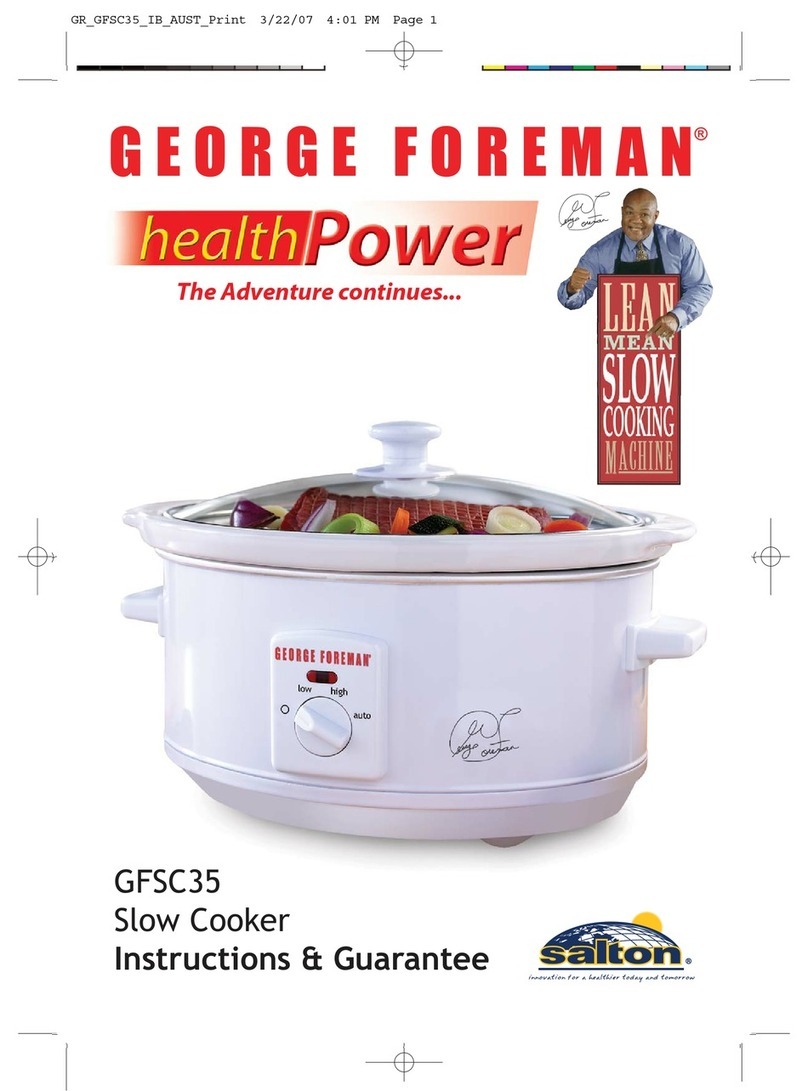
George Foreman
George Foreman GFSC35 instructions
